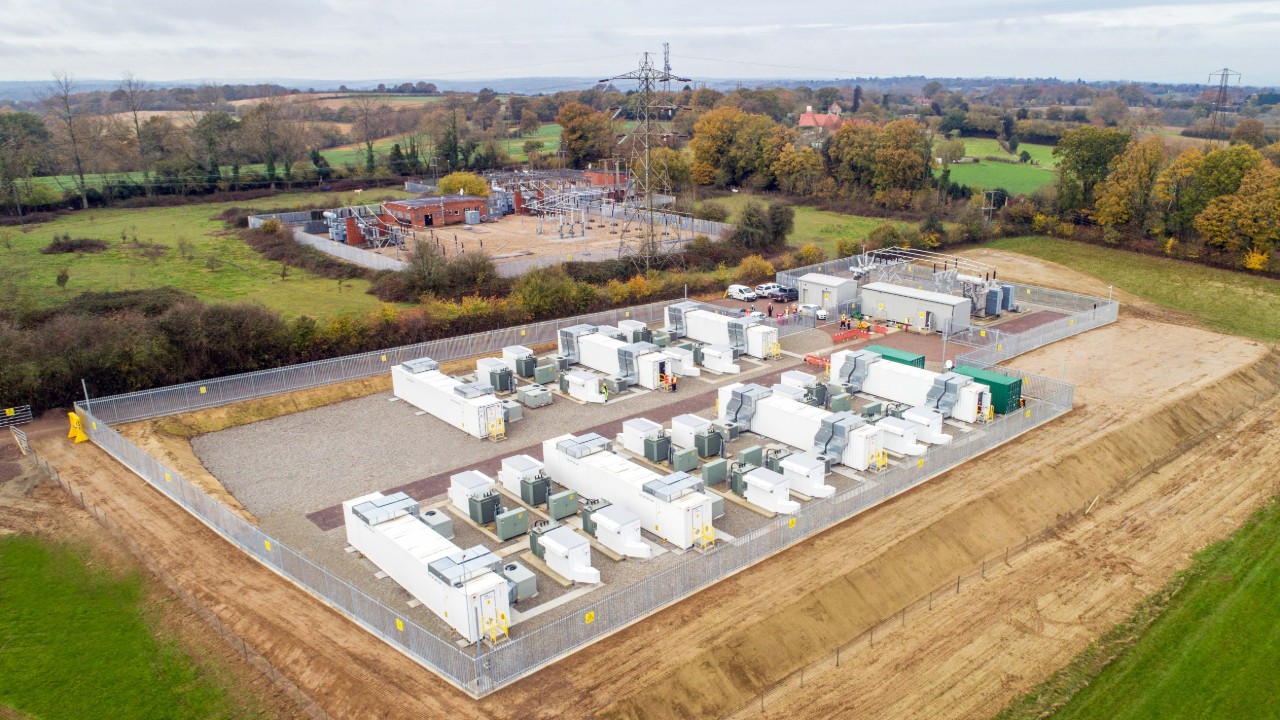
Glassenbury BESS. Image: Gresham House
Battery energy storage fund Gresham House has released annual accounts for the first half of 2023, showing lower H1 2023 revenues and a drop in share value.
In 2022, the company’s earnings before tax (EBITDA) was £48.8 million, “a like-for-like increase of 23.2%”, while the share value increased from 116.86p to 155.51p over the year. As with many renewable energy stocks, Gresham House’s share price has fallen in 2023, now sitting at around 119p. The share price stood at 146.66p at the end of H1.
However, the company says it has a 2.5GWh target portfolio which could be deployed by mid 2025 representing a 310% growth compared to 31 December 2022.
The lower H1 2023 revenues were “due to near-term systems and process challenges being addressed at National Grid Electricity System Operator (NG ESO), and cyclically low levels of power price volatility,” the company said, eyeing “strong revenue recovery potential from current levels boosted by [a] growing operational portfolio”.
Gresham House’s operational MW reached 590MW as of 30 June 2023, but now stands at 640MW, with Grendon (50MW), the Company’s first two-hour project, having become operational in July.
| Project Name | Capacity (MW) | Battery size (MWh) | Operational Status at 30 June 2023 | Ownership % | |
|---|---|---|---|---|---|
| 1 | Staunch | 20 | 3 | Operational | 100% |
| 2 | Rufford | 7 | 10 | Operational | 100% |
| 3 | Lockleaze | 15 | 22 | Operational | 100% |
| 4 | Littlebrook | 8 | 6 | Operational | 100% |
| 5 | Roundponds | 20 | 26 | Operational | 100% |
| 6 | Wolves | 5 | 8 | Operational | 100% |
| 7 | Glassenbury | 40 | 28 | Operational | 100% |
| 8 | Cleator | 10 | 7 | Operational | 100% |
| 9 | Red Scar | 49 | 74 | Operational | 100% |
| 10 | Bloxwich | 41 | 47 | Operational | 100% |
| 11 | Thurcroft | 50 | 75 | Operational | 100% |
| 12 | Wickham | 50 | 74 | Operational | 100% |
| 13 | Tynemouth | 25 | 17 | Operational | 100% |
| 14 | Glassenbury Ext. | 10 | 10 | Operational | 100% |
| 15 | Nevendon | 10 | 7 | Operational | 100% |
| 16 | Port of Tyne | 35 | 28 | Operational | 100% |
| 17 | Byers Brae | 30 | 31 | Operational | 100% |
| 18 | Arbroath | 35 | 35 | Operational | 100% |
| 19 | Enderby | 50 | 50 | Operational | 100% |
| 20 | Stairfoot | 40 | 40 | Operational | 100% |
| 21 | Couper Angus | 40 | 40 | Operational | 100% |
| Operational portfolio at 30 June 2023 | 590 | 638 | |||
| 22 | Grendon 1 | 50 | 100 | Commissioned: July 2023 | 100% |
| Current operational portfolio | 640 | 738 |
The company says its manager and board “remain very positive about the outlook for the GB BESS market and continue to be excited about maintaining GRID’s leading market position.”
However, there is a “widening gap” between installed battery storage capacity and the growth in renewables, Gresham House said, with only 2.7GW of BESS, smaller than the 2.9GW increase in renewable generation in the UK in Q1 2023. As a consequence, the battery storage industry represents a “fundamental investment opportunity”, the company said.
Revenues for 2023, however, had been lower than 2021 and 2021 and below budget, impacted by reduced consumer demand as a result of higher power prices.
“Exacerbating the current picture, National Grid ESO has not completed the modernisation of its control room and associated processes in time to be able to make effective use of BESS in the Balancing Mechanism (BM), despite the successful trials demonstrating their potential back in 2020. Instead, despite being cheaper and lower-carbon assets, batteries are consistently skipped over in favour of assets such as fossil fuel gas plants. As such, all GB BESS are earning less revenue than they should from the BM at this time,” Gresham House said.
Solar Power Portal’s sister site Current± reported that batteries have an average skip rate in the Balancing Mechanism of around 80%, often being passed up for more expensive forms of energy. Electricity Storage Network penned an open letter to National Grid ESO expressing concerns over the Balancing Mechanism in July.

